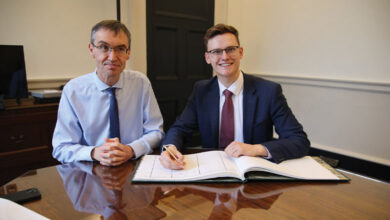Bridging the gap: Gerry Adams interview
 Gerry Adams tells Meadhbh Monahan about his first impressions of the Dáil and reflects on Sinn Féin now being “a very clear manifestation of a real all-Ireland party.”
Gerry Adams tells Meadhbh Monahan about his first impressions of the Dáil and reflects on Sinn Féin now being “a very clear manifestation of a real all-Ireland party.”
“Sinn Féin always said: ‘We are the only all-Ireland party’, but now it’s so obvious,” says Gerry Adams.
Gaining 14 seats in the 31st Dáil (and 9.9 per cent of first preferences) resulted in “the biggest team of Sinn Féin deputies elected since the twenties.” Adams was aware that Sinn Féin had reached a “step-change” when he entered the chamber on 9 March as TD for Louth. “Everyone was very conscious that this was a new phase of Sinn Féin’s development across the island,” he recalls.
Adams has been one of the main figures in Northern politics for over two decades. He was an abstentionist MP for West Belfast from 1983 to 1992 and from 1997 to 2011. Since 1998, he has been an MLA for West Belfast in the Northern Ireland Assembly. On his first day as TD for Louth, he told the Dáil he was “very proud to stand here as an Ulsterman, as an Irish republican from County Antrim.”
Nationalists “like the fact that we are making partition irrelevant,” Adams contends. “That’s never been done since the state was established. There might have been times when republicanism was in the ascendency in the North or in the ascendency in the South [but] this is the first time you’ve got the joined-up-ness.”
Practically, Sinn Féin’s quarters in Leinster House are “like a sauna”. Life for the new TDs has been “a bit frenetic since [9 March]”, with computers and PAs only being put in place in the last few weeks.
The decor of the building lends a gravitas to proceedings and the busts of the 1916 leaders in the chamber and portraits of historical figures such as Cathal Brugha, Austin Stack, and Michael Collins are “very clearly Irish and very clearly reflect the history” of the Irish state. However, Adams believes that “the majority of those whose images are depicted would not recognise the society which we have today and the type of society that they went out and struggled for and, in many cases, killed for.”
Economy
Adams finds it an “interesting irony” that, while Sinn Féin is lobbying to have more fiscal powers transferred from London to Northern Ireland, “the Irish Government is giving them away to the EU and the IMF.”
He was criticised for his knowledge of the economy during both the 2007 and the 2011 election campaigns. Even though he admitted to journalists that he didn’t know the VAT rate, Adams argues: “I don’t think [the economy] was a weak spot to tell you the truth.”
In the last three general elections, Sinn Féin’s policies on reforming the tax system and tax justice (ensuring those who can pay most, should pay most), were correct, Adams claims.
“At a time when we have the largest exchequer surpluses in the history of the state, we argued for a jobs stimulus package, drawing down money from the pension reserve fund to be a catalyst for capital projects [such as] school buildings, water infrastructure, all labour- intensive that would kick-start the construction industry. None of that was done,” he notes.
Sinn Féin warned against “the verboseness of the property bubble”, Adams continues. In the most recent election, the party also warned against bailing out the banks, saying that a functional banking system was not possible by burdening the tax-payer with sovereign and private banking debt.
Adams claims: “It would be entirely improper to go around saying: ‘We told you so’.”
At the time of interview, the Irish Central Bank revealed that the country’s banks needed a further €24 billion injection of capital, bringing the total cost of the banking bail-out to €70 billion. Adams accuses the new Government of “flip- flopping.”
He acknowledges that Fine Gael and Labour “had a good win” and “have the votes to do whatever they want” but accuses them of taking u-turns on manifesto commitments such as burning the bond-holders and not putting another “red cent” into the banks.
Despite the EU and IMF’s tight hold on Ireland’s finances, “politics is about political choices”, Adams insists.
He is critical of Kenny’s comment on 13 April that: “We have to play the hand we have been given and it isn’t a very good hand.” Adams points out that blaming Fianna Fáil “has a limited shelf- life.” He says: “Of course Fianna Fáil are to blame,” but adds: “Brian Cowen’s not Taoiseach now, Enda is the Taoiseach. It’s still a matter of political choice.”
He further criticises the Taoiseach for taking the economy and the unsustainability of the bank bail-out off the agenda at the EU summit in March.
 “I don’t agree with what passes for our negotiating strategy,” he adds. “I think we are a bit at sea and it’s [all] in Europe’s interests.” Adams believes that Kenny’s commitment to the EU-IMF deal will weaken Ireland’s negotiating position.
“I don’t agree with what passes for our negotiating strategy,” he adds. “I think we are a bit at sea and it’s [all] in Europe’s interests.” Adams believes that Kenny’s commitment to the EU-IMF deal will weaken Ireland’s negotiating position.
The major flaw in the Government’s policy is that the debt burden and the rate of interest on the loans (although being renegotiated) “is just not sustainable.”
With half a million people unemployed, 100,000 young people emigrating by this time next year and medium and small businesses unable to access credit, Adams claims that the economy has to be stimulated and the Government has to get people back to work.
“I’m a bit concerned at this revised memo of understanding,” Adams continues. The Taoiseach has “majored on the need for root and branch political reform” and Adams agrees with him. His advice to Kenny is to ensure transparency, particularly in the Government’s dealings with the EU-IMF-ECB troika.
“If you want to instil public confidence or a sense of hope in people, then you have to do the thing in a way which is both transparent and comprehensive.”
31st Dáil
Sinn Féin’s priorities for the next four years are to get people back to work, make the economy work for citizens as opposed to the other way around, end the two-tier health and education systems, ensure natural resources, including oil and gas, are used for the common good and to continue to work at the Good Friday Agreement, heading towards a united Ireland.
In addition, the party aims to “provide a relevant, constructive opposition to those aspects of government policy which we think are bad for citizens”. Adams also pledges to “act as a conjugate between citizens and political institutions” and to “bridge the big gap that has grown [because of] cynicism, scepticism and outright anger at what’s been happening in recent times.”
So far, Adams is satisfied that Sinn Féin is making an impact and is “increasingly credible.” He believes his party’s case is helped by the lack of credibility around Fianna Fáil’s 20 TDs.
“The Fianna Fáil party can’t really complain about the direction the Government is going in because the Government is implementing Fianna Fáil policy.” They “might quibble with details but both parties are on the same wavelength.” This leaves him and his deputies to “point out that the
re’s a better way of doing this”.
When asked if there is a negative attitude towards Sinn Féin among TDs, Adams responds: “Within the more conservative parties, there would be a resistance to the core republican message about equality, citizenship and people having rights, but at a personal level everybody at all levels are very, very friendly.”
Taoiseach Enda Kenny is “personable”. Wishing Kenny well, Adams notes that he “acts as a Taoiseach should act.”
In response to a number of barbed comments directed at Adams in the Dáil chamber – hinting at the assumption he was involved in the IRA, despite his continual denial – Adams tells eolas: “They’re going to keep doing that.” He adds: “It’s hardly a constructive response to the Government’s failure to deal with the banking crisis, or its failure to bring in a new tax band for those earning over €100,000, so it’s not an issue as far as I’m concerned.”
Republicanism
When asked what essentially does republicanism mean to him, he replies: “A republic is one in which everyone is a citizen. A republic is one in which the people are sovereign, both within the state and in terms of the state’s relationship with other states,” he continues.
“In Ireland, of course, it has to be national. No other government has the right to butt in or to interfere.”
He believes that the Good Friday Agreement is “a very good accord, which sets in a peaceful and democratic way, the way to win unionist support for the concept of an end to partition”.
Whether or not there is an appetite for a united Ireland, Adams believes there is “certainly an appetite for a new republic.”
Sinn Féin’s role, he contends, is to “show people who are fixated on their economic difficulties – whether they can put food on the table or whether they can clothe their kids – that the two are the opposite sides of the one coin.”
He believes that the duplication of services such as health, support for agriculture, job creation bodies and energy on such a small landmass doesn’t make sense and points out that those sectors are already becoming all-island.
“The genius of the Good Friday Agreement is that it recognises – leaving aside the constitutional issue – the single island approach,” Adams contends.
He praises the ongoing collaboration between the two finance ministers and describes as “disgraceful” the decision by the North’s former Health Minister Michael McGimpsey, not to go ahead with the radiotherapy unit at Derry’s Altnagelvin hospital.
21st century
“This isn’t 1916 or 1798 so what republicanism and citizens’ rights means in the modern era is the right to a job, a decent home, a decent education, food in your belly [and] the right to a wraparound from-the-cradle-to-the-grave health service,” Adams states. These “core principles” of a modern republic don’t exist in Ireland, he contends.
When asked if republicanism has been tarnished by violence, Adams replies that “the physical force dimension of republicanism which goes back to the very first promulgation of republicanism 200 years ago, has been a feature, mostly because those who espoused republicanism – be it United Irishmen, the IRA, the Citizens’ Army or Cumann na mBan – were violently blocked from getting a republic by the colonial power.”
He adds that that is not the case now, particularly after thirty years of the Troubles.
“There is no justification now for the action we’ve seen in recent days,” he said, referring to the murder of Catholic PSNI officer Ronan Kerr.
With the approach of the centenary of the 1916 Rising, Adams believes that a “national conversation” will take place looking at North/South integration and the meaning of republicanism. The Queen’s visit, while quite unremarkable to Adams, is also going to “spark debate”. Ultimately, republicanism needs to be modernised and made relevant to 21st century Ireland.





